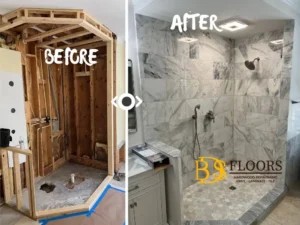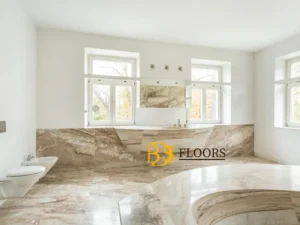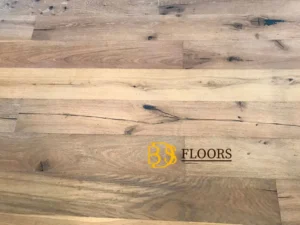Selecting the appropriate flooring is crucial in creating an ideal home office that is both practical and inspiring. Several factors were taken into account when determining the best flooring for a home office. These include the sound impact of the flooring, its compatibility with common home office furniture such as wheeled chairs, and whether it is pet-friendly. After analyzing these factors and surveying, we discovered the top types and brands of flooring for the perfect home office.
When setting up a home office, it’s important to create a functional and productive workspace that also feels comfortable and inspiring. This means considering factors like the type of furniture you have, as well as your personal style preferences. You may want to match your flooring and decor to the rest of your home or create a unique look for your office. Additionally, you should choose a flooring type that is practical and durable, especially if you anticipate high traffic. For example, if you have a swivel chair, a smooth and durable floor is essential for ergonomic purposes. Ultimately, the goal is to create a workspace that allows you to work efficiently and comfortably, while also reflecting your personal style.
What’s the best flooring for home offices?
To determine the best flooring for your home office, you should consider factors such as how well it complements your office furniture, the level of durability required, ease of maintenance, noise absorption, and the overall look and feel you want to create. It’s important to choose a flooring that strikes a balance between practicality, comfort, and aesthetics. There are several flooring options available for home offices, including wood, vinyl, laminate, carpet, and tile, which can be chosen based on individual preferences and specific requirements.
The design and style of your home office will depend on your job type and the frequency of face-to-face interactions with clients. Regardless of this, it’s important to create a calming, organized, and inviting workspace. Selecting the appropriate flooring is the first step towards establishing the foundation of your home office design. Flooring options like vinyl, wood, and laminate offer various design possibilities to suit any style and budget. Apart from flooring, furniture, lighting, color schemes, and accessories all contribute to your office’s overall style. For inspiration and ideas on how to create your ideal home office, check out our inspiration pages showcasing different design styles.

Selecting a suitable area for your home office is crucial. A spare bedroom or a peaceful section of your home, such as a renovated basement or finished attic space, would be ideal. If you have a basement home office, you may benefit from a separate entrance for visitors and the ability to include a small kitchenette for refreshments. However, if space is limited, you must be innovative and explore infrequently used corners or areas around your house. Even a small area, such as a dining table or a stair landing, can be turned into a workstation. Nonetheless, if you cannot allocate an entire room for your home office, make sure that your workspace can be easily stowed away or that documents and paperwork can be quickly concealed to help you maintain a healthy work-life balance.
Flooring is an important aspect to consider when creating a home office. If you have the option to choose flooring for your workspace, it’s crucial to select the appropriate type that suits the space’s purpose. Noise reduction is a key factor to consider, particularly if you frequently hold conference calls or video chats. You want to avoid disrupting other household members, especially young children or babies. The type of flooring you choose should also depend on how often the workspace is used. For everyday use, opt for a durable material that can handle wear and tear, including spilled coffee, messy paints or art mediums. However, for occasional use such as bill paying once a month, you can choose a more affordable option. To help you decide on the right flooring for your home office, Twenty & Oak recommends these options.
When it comes to home office flooring, both solid and engineered hardwood are excellent choices that offer durability, elegance, and increased home value. They are also easy to clean and allergen-free, and come in a range of styles, treatments, stains, and plank sizes to fit your design preferences. However, it’s worth noting that solid hardwood is more suitable for milder climates and upper levels of a home, whereas engineered hardwood can be installed on any level, including in a basement home office. If you choose hardwood flooring, it’s important to use a decorative rug or floor mat under your rolling chair and attach felt pads to heavier furniture pieces to prevent damage.

Vinyl Plank
Vinyl flooring is a practical choice for a home office due to its durability and low maintenance. It can handle heavy foot traffic and sliding office chairs without scuffing or staining, thanks to its protective top layer. Some types of vinyl have a cushioned backing that absorbs sound and makes them quiet to walk on, providing both comfort and noise reduction. Additionally, vinyl has good thermal properties that make it comfortable to work on year-round. With a variety of styles, patterns, colors, and plank sizes to choose from, vinyl flooring offers plenty of design options to suit your preferences and create an inviting workspace.
The first recommended flooring for a home office is luxury vinyl plank (LVP), which is an ideal choice due to its sturdiness, affordability, and adaptability. It is effortless to clean and maintain and comes in various styles, including wood and stone designs. While some people may consider it as imitation wood flooring, LVP remains the optimal choice for a home office.
If you are considering flooring options for your home office, luxury vinyl plank is an excellent choice for several reasons. Firstly, it is incredibly durable, resistant to wear and tear, and can handle heavy foot traffic, making it an ideal option for frequently used spaces. It is also budget-friendly and can mimic the appearance of more expensive flooring options. Moreover, it comes in a vast range of styles, colors, and patterns, allowing you to find a design that matches your decor preferences. Vinyl plank is also easy to clean and maintain and can withstand spills and accidents, making it a practical option for pet owners. Finally, it provides additional comfort as it is softer underfoot than other hard flooring options, such as tile or hardwood, which is beneficial for those who spend long hours standing or walking around in their home office.
While luxury vinyl plank flooring is a popular choice for home offices, it is essential to consider the potential drawbacks. There are two significant cons to keep in mind: Firstly, standing for extended periods on vinyl plank flooring may cause fatigue, especially if you have recently invested in a standing desk. Secondly, like other hard surface flooring options, such as hardwood and laminate, vinyl plank flooring can transmit sound more efficiently than carpeted floors.
If you are wondering whether to place a rug in your home office, the answer is yes. Not only will it enhance the room’s warmth and comfort, but it will also protect the floor from scratches. Additionally, an area rug in your home office can reduce noise levels by absorbing sound, which is beneficial if you frequently make phone calls or participate in Zoom video meetings.
Vinyl tile and plank flooring can imitate the appearance of various flooring materials, including hardwood and marble tile, while offering greater durability in high-traffic areas. Vinyl plank is also a cost-effective alternative for those who desire the look of genuine hardwood, while vinyl tile can replicate the appearance of natural stone or ceramic. Moreover, vinyl flooring is easy to maintain and an excellent choice for homeowners who prefer to do their own installations.
Sheet vinyl flooring is an affordable option for home offices and comes in a variety of designs that can resemble anything from hardwood to stone, tile, and even stained concrete for an industrial look. Vinyl sheet with textile backing can also provide a warm underfoot, which is ideal for basement home offices, as well as sound absorption that adds acoustical value to large spaces.
While there are numerous flooring options available, carpet may not be the best choice if you need to use an existing room as is, as it can make it difficult to roll around in an office chair.
If you’re ready to renovate your home office, you can use our Floor Genius Quiz to find the perfect flooring option, or browse our virtual flooring showroom to explore our vast collection.
Hardwood
Hardwood flooring is an ideal choice for a home office, as it provides a professional and sophisticated look that can increase the value of your property. With many types available, including solid and engineered wood, hardwood flooring is a durable and long-lasting option that can withstand daily use without showing signs of wear and tear. It also offers a variety of colors and styles to choose from, making it easy to find one that complements your office décor. Another benefit of hardwood flooring is its hypoallergenic nature, which is perfect for those who suffer from allergies or asthma. By not trapping dust, pet dander, or other allergens like carpet, it can improve air quality and promote better health in your home office.
If you have hardwood flooring in your home, it makes sense to have it in your home office as well. While hardwood floors can be expensive, they are durable and long-lasting. Both solid and engineered hardwood flooring options are available and offer practicality and beauty. There are many different colors, wood grains, and textures available for both options. Tarkett offers a variety of wood flooring options that are available in both contemporary and traditional designs with different finishes and features that can bring a touch of style and elegance to your home office.
Although hardwood flooring is an elegant choice for a home office, there are some drawbacks to consider. These include:
- Cost: Hardwood flooring can be pricier than other flooring options, and the cost can vary depending on the type of wood and installation method.
- Maintenance: Regular maintenance is required to keep hardwood flooring looking good, and it may not be the best option if you have pets or children. Refinishing may also be necessary over time.
- Noise: Hardwood floors can create noise from footsteps, pet claws, and dropped objects, especially in multi-story homes or apartments.
- Hardness: Although hardwood is durable, it can be prone to scratches and dents. Harder woods may be more resistant to damage, but heavy furniture or dropped objects can still cause damage.
- Installation: Installing hardwood flooring can be time-consuming, complex, and may require special tools and equipment. Mistakes can be costly and create a lot of dust throughout the house.
Carpet
Carpet is a popular flooring option for home offices due to its comfort, sound absorption, style, affordability, and safety benefits. It provides a soft and comfortable surface for walking and standing, reducing fatigue and providing insulation against cold floors. Carpet also absorbs sound, making it a quieter workspace and a good option if you are constantly on calls. It comes in a wide range of colors, patterns, and textures, allowing you to choose a style that complements your office’s decor and personal taste. Additionally, carpet is often less expensive than other types of flooring, such as hardwood or vinyl plank, and it provides a safer surface for children, pets, and elderly individuals who may be more prone to slips and falls.
To some extent, carpet can offer comfort, style, and affordability to your home office, but it also has some downsides that should be considered. Maintaining and cleaning carpet requires time and sometimes professional cleaning. Also, carpet traps allergens and can be stained more easily than other flooring types. In addition, the durability of carpet can be affected by wear and tear, and it can absorb odors from spills, pets, and other sources. These factors can be problematic, especially for those who have allergies or work from home often.
Laminate
Laminate flooring is a flooring option that closely resembles high-quality wood and stone finishes. With a vast selection of designs available, ranging from realistic to artistic, it’s easy to find a laminate floor design that suits your home office. Laminate flooring is also durable, thanks to its extra-strong wear layer that resists scuffs, scratches, and stains, and is easy to clean. The flooring is also easy to install, making it a great option for DIY enthusiasts.
Laminate flooring is a versatile and durable option that can provide a long-lasting solution for your home office. This type of flooring is perfect for homeowners who desire the appearance of genuine hardwood but at a more affordable price. Additionally, laminate flooring is known for its resistance to stains and fading, making it an ideal choice for high-traffic areas and households with pets and children. The laminate collections available on Twenty & Oak are even water-resistant, and some options, like Beauflor Hydrana, come with an attached pad that helps to reduce noise.
One disadvantage of laminate floors is that they can produce a hollow sound. With the constant movement of swivel chairs, phone calls, and client visits, this may cause some noise disturbance. However, you can reduce this by installing a quality underlayment, which will help to absorb noise and provide added comfort underfoot.
Conclusion: What’s the flooring and flooring brands for a home office?
To conclude, it is recommended to consider highly rated flooring brands that offer a diverse selection of luxury vinyl plank, hardwood, and carpet styles for your home office.







